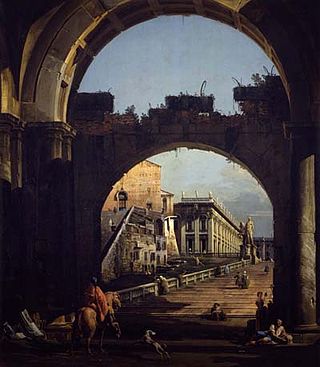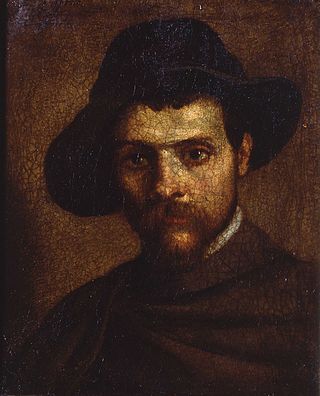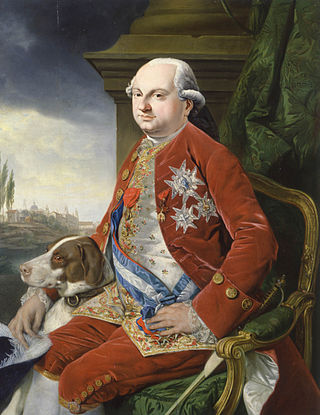
Annibale Carracci was an Italian painter and instructor, active in Bologna and later in Rome. Along with his brother and cousin, Annibale was one of the progenitors, if not founders of a leading strand of the Baroque style, borrowing from styles from both north and south of their native city, and aspiring for a return to classical monumentality, but adding a more vital dynamism. Painters working under Annibale at the gallery of the Palazzo Farnese would be highly influential in Roman painting for decades.

Alessandro Tiarini was an Italian Baroque painter of the Bolognese School.

Bartolomeo Schedoni was an Italian early Baroque painter from Modena.
Sergio Zanni is an Italian painter and sculptor. After obtaining the Diploma at the Institute of Arts 'Dosso Dossi' in Ferrara, Italy, he graduated from the Academy of Arts in Bologna. He taught in the Institute of Arts 'Dosso Dossi' until 1995. For his research in sculpturing he utilized backed clay and, successively, lighter material for sculptures of large dimensions.
Riccardo Fainardi (1865–1959) was an Italian painter, sculptor and interior designer, noted for his contributions to buildings. He was born in Collecchio, Parma and died in Gaiano, Parma. Notable works include the Chiesa di Fornovo Taro in Fornovo di Taro, Parma in 1882 and the Chiesa di Sant'Andrea of Capri in 1900.

The Enthroned Madonna and Child with Saints is a triptych painting in tempera and gold leaf on panel by Agnolo Gaddi.

The Madonna and Child with Saints Michael the Archangel and Andrea is a Cima da Conegliano painting oil on panel dating from c. 1496–1498, and preserved at the Galleria nazionale di Parma.

Archangel Michael fights the devil and the Virgin of the Assumption of the Angels is an oil painting on canvas of Dosso Dossi and Battista Dossi, dated to about 1533 to 1534 and preserved at the Galleria nazionale di Parma.

Madonna della Scodella is an oil painting on panel by Antonio da Correggio, dated from 1528 to about 1530 and preserved at the Galleria nazionale di Parma.

The portrait of Don Philip of Bourbon Family is an oil painting on canvas of Giuseppe Baldrighi, dated to about 1757 and preserved in the Galleria Nazionale Di Parma.

Healing of the Man Born Blind is a c.1573 painting by El Greco, showing the healing the man blind from birth. It is now in the Galleria nazionale di Parma. It is signed at the bottom right-hand corner. It shows the artist returning to a theme he had first painted five years earlier, in a work now in Dresden.

Pope Paul III with a Nephew is an unfinished 1534 oil on slate portrait by Sebastiano del Piombo, now in the Galleria nazionale di Parma. The nephew's identity is unclear but the painting's presumed date suggests it may be Ottavio Farnese, whom Pope Paul III made Duke of Parma and Piacenza soon after the work's date

Deesis with Saint Paul and Saint Catherine is an oil on panel painting by Giulio Romano, executed c. 1520, now in the Galleria nazionale di Parma. Its title refers to deesis, a subject in Christian iconography, shown here with Paul of Tarsus and Catherine of Alexandria in the lower register and the Virgin Mary and John the Baptist in the upper.

Mystic Marriage of Saint Catherine or Mystic Betrothal of Saint Catherine is a c.1524 oil on canvas painting by the Italian Renaissance painter Parmigianino. The work is now in the Galleria nazionale di Parma. Art historians argue that the work may be attributed to the period in which Parmigianino was painting his first works in the church of San Giovanni Evangelista, as also emerges from a recent restoration, which has shown that its technique is near-identical to that of Parmigianino - "no underdrawing, pigment use, descriptive speed, drafting of final shadows, using fingers and brush-ends as tools".

Capriccio with the Campidoglio is a c. 1742 oil-on-canvas painting by the Italian artist Bernardo Bellotto. It was acquired by count Stefano Sanvitale di Parma in 1835 and then exhibited in the Galleria nazionale di Parma, where it now hangs alongside another painting originally produced as its pendant.

Self-Portrait is a 1593 oil on canvas painting by Annibale Carracci, now in the Galleria Nazionale di Parma. It is dated 17 April 1593 on the top left of the canvas.

Pietà with Saints Clare, Francis and Mary Magdalene is a 1585 oil on canvas painting by Annibale Carracci, now in the Galleria nazionale di Parma.

Madonna and Child with Saints is an oil on canvas painting by Agostino Carracci, from 1585, dated on the lowest step of the Virgin Mary's throne. An example of a sacra conversazione. Long in the Benedictine abbey of San Paolo in Parma, French troops took it to Paris in 1796 and on its return to Italy in 1816 it was moved to the Galleria nazionale di Parma, where it still hangs.

The Dead Christ Mourned is an oil painting on canvas of c. 1604 by Annibale Carracci. It was in the Orleans Collection before arriving in Great Britain in 1798. In 1913 it was donated to the National Gallery, London, which describes it as "perhaps the most poignant image in [its] collection of the pietà – the lamentation over the dead Christ following his crucifixion – and one of the greatest expressions of grief in Baroque art".

The Portrait of Ferdinand I, Duke of Parma is an oil-on-panel painting by German artist Johann Zoffany, executed in 1778-1779. It is held at the Galleria nazionale di Parma. The painting was already part of the museum collection in 1791, exhibited in the Meeting Room of the Academy of Fine Arts of Parma.


















